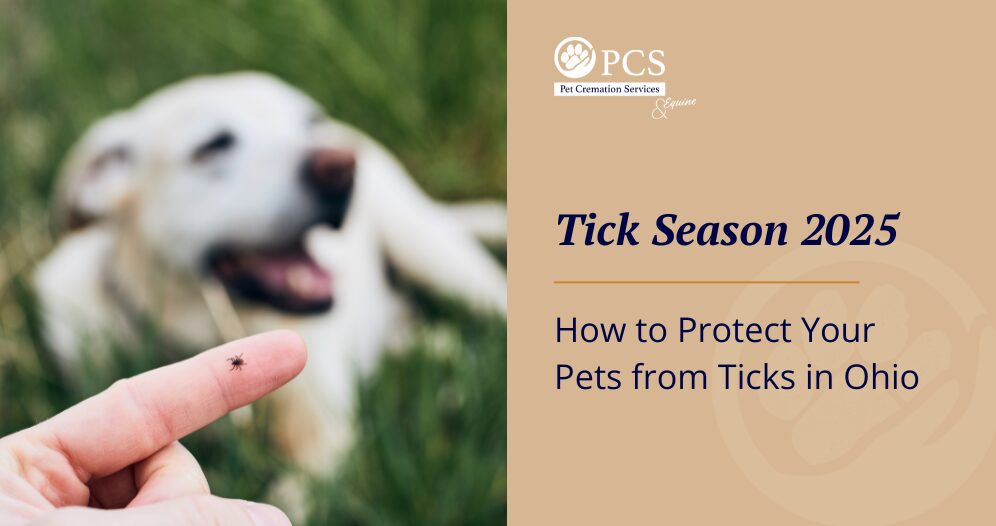
Tick season is here, and while it’s important to stay vigilant year-round, Ohioans need to be especially alert as we head into the warmer months. Tick populations have been steadily increasing across the state. In fact, cases of Lyme disease nearly tripled from 2022 to 2023. Experts expect 2025 to be another high-risk year for tick activity.
And while we often think of ticks as a human health concern, our pets are just as vulnerable.
Where Do Pets Get Ticks in Ohio?
Animals – especially dogs – are exposed to ticks more than we’d like to think. Whether it’s playing in the yard, going on a walk around the neighborhood, or spending an afternoon at the dog park, our furry friends hangout in the same environments ticks thrive in. Ohio tick species are commonly found in:
- Uncut lawns and brushy areas
- Shrubs and grassy clearings
- Humid environments—even in suburban backyards
- Kennels or pet boarding facilities (less common, but possible)
Even a quick trip outside can expose your pet to ticks that are lying in wait, ready to latch on when your pet brushes past.
Why It’s Important to Protect Pets from Ticks
Ticks might be tiny, but they can carry dangerous diseases that affect both animals and people. Here are a few of the most common tick species in Ohio—and what they could mean for your pet:
- American Dog Tick – This tick can spread Rocky Mountain Spotted Fever (RMSF) and more rarely, Tularemia, to your pets. Both illnesses usually show up as a high fever, lethargy, swollen joints and lymph nodes, and can be serious if not treated promptly.
- Black-legged Tick – Also known as deer ticks, black-legged ticks are known carriers of Lyme Disease, which can be transferred to canines and rarely, felines. It’s a bit tricky to diagnose however, as only 5-10% of infected dogs will show signs of Lyme disease. A 30-day course of antibiotics should clear up the infection, but 1-5% of infected dogs can develop a life-threatening kidney disease called Lyme nephritis.
- Lone-star tick – These ticks are a bit of a wildcard, carrying illnesses including tularemia, RMSF, Bobcat Fever and ehrlichiosis. Bobcat fever does not affect dogs but can be deadly in cats if not treated promptly. Ehrlichiosis, on the other hand, is rarer but can also be fatal in dogs and cats if not treated quickly.
These aren’t the only tick species in Ohio, but they are among the most common—and dangerous.
What to Do if You Find a Tick on Your Pet
If a tick has made its way onto your pet – don’t panic. Many ticks don’t latch immediately to their hosts, and first roam around a bit before finding an ideal spot. If you find an unattached tick on your pet – you don’t have anything to worry about, as it hasn’t had a chance to feed or transmit disease.
If you find an attached tick, on the other hand, you’ll want to follow these steps:
- Remove it immediately – don’t wait for a vet visit. Use fine-tipped tweezers and grasp the tick as close to the skin as possible. Pull upward slowly and steadily, but don’t twist.
- Disinfect the area with antiseptic.
- Save the tick in a sealed bag or jar for identification.
- Watch for symptoms (fever, lethargy, swelling) over the next few weeks.
Tick Prevention for Pets
While there is a Lyme disease vaccine available for dogs that can be fairly effective, many other tickborne illnesses don’t have vaccines. To help protect your furry friend from these diseases, try the following prevention tips:
- Monthly oral preventatives: Veterinarians can prescribe monthly medication that kill ticks after they bite.
- Topical treatments or tick collars: Because oral preventatives are designed to kill ticks once they bite, you should also consider one of these tick repellants to provide an extra layer of protection.
- Post-outdoor check-ins: After walks or playtime, brush or towel off your pet to get any loose ticks off your pet. These should be disposed of immediately by flushing them or submerging them in alcohol.
Your veterinarian will be able to provide the best recommendation for tick prevention based on your pet’s breed, age, and weight.
At Pet Cremation Services, we want your furry companions to enjoy a long, healthy life. And when it comes to protecting your pets from ticks, a little awareness and a proactive routine can go a long way. Staying alert during peak season—and knowing what to watch for—can make all the difference in keeping tick-borne illnesses at bay. If you ever spot something unusual or have concerns about your pet’s health, don’t wait to contact your veterinarian .

